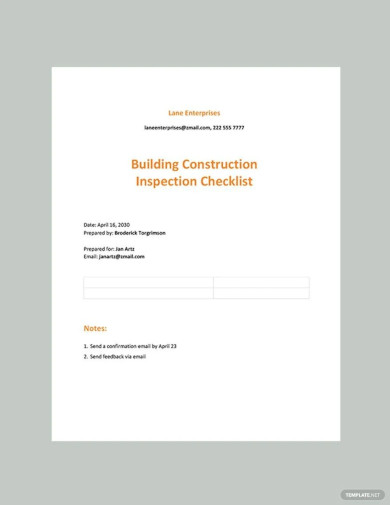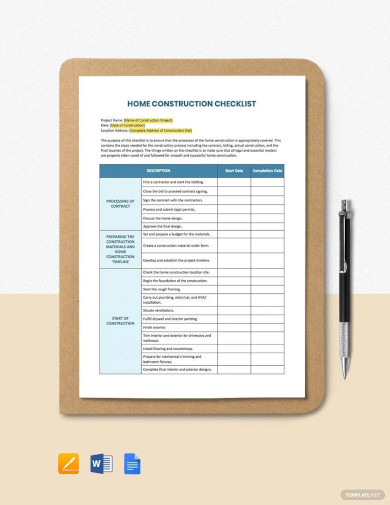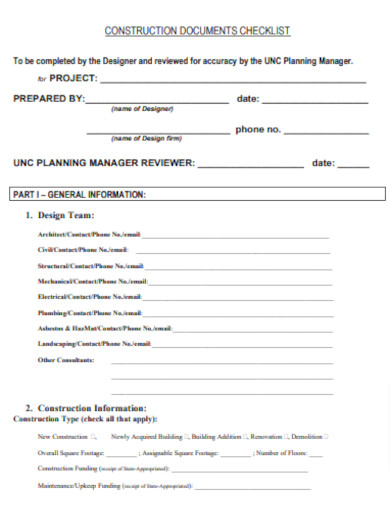24+ Sample Construction Checklist
-

Building Construction Inspection Checklist
download now -

Home Construction Checklist
download now -

Construction Marketing Checklist
download now -

Construction Project Checklist
download now -

Construction Inspection Checklist
download now -

Construction Site Checklist
download now -

Residential Construction Checklist
download now -

Commercial Construction Checklist
download now -

Walkthrough Construction Checklist
download now -

Project Management Construction Checklist
download now -

Quality Assurance Construction Checklist
download now -

Construction Materials Checklist
download now -

Construction Contract Checklist
download now -

Simple Construction Checklist
download now -

Construction Plan Checklist
download now -

Construction Management Checklist
download now -

Construction Completion Checklist
download now -

Supervisors Construction Checklist
download now -

Final Construction Checklist
download now -

Unit Substation Construction Checklist
download now -

Pre-Construction Checklist
download now -

Construction Documents Checklist
download now -

Construction Facility Checklist
download now -

Sample Construction Checklist
download now -

Printable Construction Checklist
download now
FREE Construction Checklist s to Download
24+ Sample Construction Checklist
Definition
Why a Construction Checklist is Essential
Crafting the Perfect Construction Checklist
Key Components of a Comprehensive Checklist
Embracing Technology: Modern Checklist Management
Beyond the Build: Using Checklists for Maintenance and Upkeep
Checklists for Regular Upkeep
Benefits of Maintenance Checklists
Challenges in Construction Checklist Management
FAQ’S
Are construction checklists one-size-fits-all?
What if tasks on the checklist are not completed on time?
Who is responsible for creating and maintaining the construction checklist?
How often should the checklist be reviewed during construction?
How detailed should a construction checklist be?
Definition
A well-prepared construction checklist is a detailed planning that outlines all the necessary tasks, materials, and steps required for a construction project, ensuring efficiency and preventing delays, budget overruns, and compromised quality.
Why a Construction Checklist is Essential
In the vast, intricate domain of construction, attention to detail is not just a virtue; it’s a necessity. The construction process encapsulates numerous tasks, sequences, stakeholders, and potential pitfalls. A construction checklist acts as a safeguard against the labyrinth of tasks that need execution, ensuring that each step, no matter how minuscule, is executed with precision and coherence. Here are the fundamental reasons underscoring the indispensability of a construction checklist:
Memory Enhancement:
The sheer volume of tasks in a construction project can be overwhelming. A checklist ensures that no task, irrespective of its size, is overlooked.
Standardization:
A checklist provides a standardized protocol for various construction processes, ensuring that each task is executed consistently, regardless of the team or the individual in charge.
Enhanced Accountability:
With a clear delineation of tasks, responsibilities can be allocated definitively. It becomes easier to track who is responsible for what, promoting accountability.
Risk Mitigation:
Construction is rife with potential hazards. A comprehensive checklist ensures that safety protocols are strictly adhered to, reducing the likelihood of accidents.
Efficiency and Productivity:
A well-structured checklist streamlines operations. Teams know exactly what needs to be done next, reducing downtime and improving productivity.
Client Communication:
Sharing a checklist with clients can foster transparency. It allows them to understand the progress, manage expectations, and instills confidence in your systematic approach.
Budget Adherence:
Financial deviations can be minimized by ensuring that each task is executed as planned. Any additional requirements or changes can be documented and budgeted for in real-time.
Legal Protection:
In the event of disputes, a completed checklist can serve as evidence that all stipulated tasks were completed in accordance with agreed-upon standards.
Quality Assurance:
Checklists act as a quality control tool, ensuring that every aspect of the project aligns with the desired standards and specifications.
Post-Project Review:
After the project’s completion, checklists can serve as a reference for evaluating performance, understanding areas of improvement, and refining future approaches.
In sum, a construction checklist is much more than a mere list of tasks; it’s a cornerstone of effective project management. It transforms the abstract intricacies of a construction project into tangible, actionable steps, ensuring the journey from blueprint to edifice is smooth, efficient, and impeccable.
Crafting the Perfect Construction Checklist
Detailed Scope
Understand the breadth and depth of the project. From foundation to finishing touches, nothing should be left to ambiguity.
Division of Labor
Allocate tasks based on expertise and hierarchy. Everyone involved should know their role and responsibilities.
Prioritization
Recognize which tasks are critical and which can wait. Time management is crucial.
Key Components of a Comprehensive Checklist
1.Pre-Construction Planning:
Site analysis
Acquiring permits
Stakeholder consultations
2.On-Site Activities:
Safety protocols and equipment checks
Quality control checks
3.Post-Construction Tasks:
Final inspections and approvals
Client walkthroughs
Embracing Technology: Modern Checklist Management
Gone are the days of pen and paper. With construction management software, checklists can now be dynamic, collaborative, and real-time. Discover tools that can streamline this process. The construction sector, traditionally seen as conservative and resistant to change, is undergoing a renaissance. One of the most palpable transformations is the integration of technology into various facets of the construction process, including the once humble checklist. Modern checklist management, powered by technological advancements, is revolutionizing how construction projects are planned, tracked, and executed. Here’s an exploration of this technological infusion:
Digital Checklists:
Gone are the days of paper-based lists that are susceptible to wear and tear, loss, or damage. Digital checklists, accessible via tablets and smartphones, ensure that data is available at one’s fingertips, anytime, anywhere.
Real-Time Collaboration:
Cloud-based checklist management systems allow multiple stakeholders to access, edit, and update checklists in real-time, fostering collaboration and ensuring that everyone is on the same page.
Instant Notifications:
Automated alerts and notifications ensure that tasks are not forgotten. For instance, if a critical safety check is overdue, relevant personnel receive instant notifications.
Integration with Other Systems:
Modern checklist tools can integrate seamlessly with other software like Project Management Systems, Building Information Modeling (BIM), or Inventory Management, providing a holistic view of the project.
Data Analytics:
With digital checklists, the collected data can be analyzed to derive insights. Patterns of delay, recurrent issues, or areas of efficiency can be identified, offering valuable feedback for future projects.
Interactive Media:
Modern checklists aren’t limited to text. They can include photos, videos, and voice notes, providing a richer context and facilitating clearer communication.
Geotagging:
Certain checklist tasks can be geotagged, ensuring that they are only completed when the individual is at the specified location, adding an additional layer of verification.
Safety Enhancements:
Augmented reality (AR) can be integrated into checklists for safety procedures. For instance, using AR glasses, a worker can see a checklist overlaid onto the actual equipment they’re inspecting, ensuring nothing is overlooked.
Template Libraries:
Modern checklist software often comes with libraries of pre-defined templates for various construction processes, which can be customized as per project requirements, saving time.
Historical Data Access:
Digital checklists can be archived and accessed for reference, ensuring that learnings from past projects are available for current and future endeavors.
Beyond the Build: Using Checklists for Maintenance and Upkeep
Once the final brick is laid, the last paint stroke is applied, and the keys are handed over, one might think the job of construction professionals is done. But the true longevity of any construction project lies not just in its creation but in its sustained maintenance and upkeep. Herein, the role of checklists becomes invaluable, extending far beyond the initial build.
The Post-construction Phase
The post-construction phase is a critical time. Structures begin their interaction with elements, occupants start using the facilities, and wear and tear become inevitable. As years pass, without regular maintenance, even the most robustly constructed buildings can deteriorate. This is where maintenance checklists play a pivotal role.
Checklists for Regular Upkeep
- Structural Integrity Checks: Periodic checks for foundational stability, wall cracks, ceiling strength, and roof inspections ensure that the structure remains sound over time.
- Electrical Systems Review: A checklist that ensures regular examination of wiring, circuit breakers, outlets, and other electrical components can prevent potential hazards.
- Plumbing and Drainage Inspection: To avoid leaks, water damage, or blockages, a plumbing checklist is crucial. This includes inspection of pipes, drainage systems, and sanitary fixtures.
- HVAC Maintenance: Heating, ventilation, and air conditioning systems require regular checks for efficiency, filter replacements, and duct cleanings.
- Exterior Maintenance: This covers everything from landscaping upkeep, paint touch-ups, to driveway and pathway inspections.
- Safety and Security: Regular checks of security systems, alarms, emergency exits, and fire safety equipment can be life-saving.
- Interior Inspections: Checking for mold, ensuring paint is in good condition, and inspecting flooring and ceilings are all part of an exhaustive interior checklist.
Benefits of Maintenance Checklists
- Proactive Approach: Instead of reacting to problems, checklists ensure a proactive approach, catching issues before they escalate.
- Cost-Efficiency: Addressing minor repairs promptly can save significant amounts that might otherwise be spent on major restorations.
- Sustained Property Value: Regular maintenance ensures that the property retains (or even increases) its value over time.
- Safety: Regular checks, especially of electrical and fire systems, ensure the safety of occupants.
- Prolonged Lifespan: A well-maintained structure lasts significantly longer than one that’s neglected.
Challenges in Construction Checklist Management
Construction checklists are undeniably valuable tools that guide teams through complex processes, ensure compliance with standards, and maintain safety protocols. However, as with any system, there are inherent challenges that professionals must navigate. Here’s a deeper dive into the complexities surrounding construction checklists:
1. Over-Reliance on the Checklist
While checklists are beneficial, an over-reliance can lead to a robotic approach to tasks. Construction is dynamic, and situations often require nuanced judgment that might not be outlined in the checklist.
2. Length and Complexity
Extremely detailed checklists, while thorough, can be cumbersome to utilize. If the list becomes too lengthy or complex, users might skip steps or overlook essential details, defeating the checklist’s purpose.
3. Keeping It Updated
The construction industry is continuously evolving with new techniques, materials, and regulations. If the checklist is not regularly updated, it might become obsolete, leading to outdated practices.
4. Uniformity vs. Specificity
A standardized checklist might not cater to the unique requirements of every project. On the other hand, overly specialized lists can make it hard to generalize across various projects.
5. Training and Familiarity
Introducing a new or revised checklist requires training. Ensuring every team member is familiar with and adheres to the checklist can be a logistical challenge.
6. Technology Integration
With the rise of construction management software and mobile apps, integrating paper-based checklists can be tricky. Conversely, digital checklists might face resistance from those more accustomed to traditional methods.
7. Compliance and Verification
Merely ticking off items doesn’t ensure tasks are completed to the required standard. Verifying that each checklist item is genuinely addressed and complies with set benchmarks is a significant challenge.
8. Feedback Loop
For a checklist to be effective, there needs to be a system for feedback. If issues or discrepancies aren’t reported and addressed, the same mistakes might get repeated in future projects.
9. Accessibility
Ensuring that the checklist is easily accessible to everyone on the site, irrespective of where they are or what task they are performing, can pose challenges, especially on large sites.
10. Overemphasis on Accountability
While checklists are meant to increase accountability, there’s a fine line between responsibility and blame. Overemphasis on penalizing missed items might create a counterproductive environment of fear.
FAQ’S
Are construction checklists one-size-fits-all?
No. While there may be common elements across projects, each construction project is unique. Checklists should be tailored to suit the specific requirements, challenges, and scope of each project.
What if tasks on the checklist are not completed on time?
It’s essential to have a system in place to address delays or missed tasks. This can involve rescheduling, reallocating resources, or holding accountability meetings to discuss challenges and solutions.
Who is responsible for creating and maintaining the construction checklist?
Typically, the project manager or lead contractor is responsible for creating the initial checklist. However, maintaining it—marking off completed tasks, adding new items, or making modifications—can be a collaborative effort involving various team members.
How often should the checklist be reviewed during construction?
Regularly. Depending on the project’s scale, a daily or weekly review might be appropriate. Crucial phases or milestones in the project may require more frequent checks.
How detailed should a construction checklist be?
The level of detail depends on the project’s complexity. However, it’s often recommended to be as detailed as possible, outlining every task, even those that may seem minor. This ensures every aspect of the project is accounted for.
In the orchestra of construction, the checklist is the conductor, ensuring each section plays its part flawlessly. Whether you’re a seasoned builder or embarking on your first project, the construction checklist remains your most trusted ally. By the end of this journey, one thing is clear: constructing without a checklist is like building castles in the air—lacking foundation and bound to crumble.
